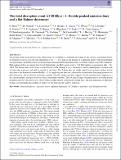Files in this item
The tidal disruption event AT 2018hyz - I : double-peaked emission lines and a flat Balmer decrement
Item metadata
| dc.contributor.author | Short, P. | |
| dc.contributor.author | Nicholl, M. | |
| dc.contributor.author | Lawrence, A. | |
| dc.contributor.author | Gomez, S. | |
| dc.contributor.author | Arcavi, I. | |
| dc.contributor.author | Wevers, T. | |
| dc.contributor.author | Leloudas, G. | |
| dc.contributor.author | Schulze, S. | |
| dc.contributor.author | Anderson, J. P. | |
| dc.contributor.author | Berger, E. | |
| dc.contributor.author | Blanchard, P. K. | |
| dc.contributor.author | Burke, J. | |
| dc.contributor.author | Castro Segura, N. | |
| dc.contributor.author | Charalampopoulos, P. | |
| dc.contributor.author | Chornock, R. | |
| dc.contributor.author | Galbany, L. | |
| dc.contributor.author | Gromadzki, M. | |
| dc.contributor.author | Herzog, L. J. | |
| dc.contributor.author | Hiramatsu, D. | |
| dc.contributor.author | Horne, Keith | |
| dc.contributor.author | Hosseinzadeh, G. | |
| dc.contributor.author | Howell, D. Andrew | |
| dc.contributor.author | Ihanec, N. | |
| dc.contributor.author | Inserra, C. | |
| dc.contributor.author | Kankare, E. | |
| dc.contributor.author | Maguire, K. | |
| dc.contributor.author | McCully, C. | |
| dc.contributor.author | Müller Bravo, T. E. | |
| dc.contributor.author | Onori, F. | |
| dc.contributor.author | Sollerman, J. | |
| dc.contributor.author | Young, D. R. | |
| dc.date.accessioned | 2020-11-13T13:30:01Z | |
| dc.date.available | 2020-11-13T13:30:01Z | |
| dc.date.issued | 2020-11 | |
| dc.identifier | 271202572 | |
| dc.identifier | 80520180-2264-478a-a014-8ed0d4d16232 | |
| dc.identifier | 85095867069 | |
| dc.identifier | 000587752500081 | |
| dc.identifier.citation | Short , P , Nicholl , M , Lawrence , A , Gomez , S , Arcavi , I , Wevers , T , Leloudas , G , Schulze , S , Anderson , J P , Berger , E , Blanchard , P K , Burke , J , Castro Segura , N , Charalampopoulos , P , Chornock , R , Galbany , L , Gromadzki , M , Herzog , L J , Hiramatsu , D , Horne , K , Hosseinzadeh , G , Howell , D A , Ihanec , N , Inserra , C , Kankare , E , Maguire , K , McCully , C , Müller Bravo , T E , Onori , F , Sollerman , J & Young , D R 2020 , ' The tidal disruption event AT 2018hyz - I : double-peaked emission lines and a flat Balmer decrement ' , Monthly Notices of the Royal Astronomical Society , vol. 498 , no. 3 , pp. 4119–4133 . https://doi.org/10.1093/mnras/staa2065 | en |
| dc.identifier.issn | 0035-8711 | |
| dc.identifier.other | ArXiv: http://arxiv.org/abs/2003.05470v2 | |
| dc.identifier.uri | https://hdl.handle.net/10023/20967 | |
| dc.description | Published in MNRAS. Accompanied by companion paper Gomez et al. (2020). Funding: KH acknowledges support from STFC grant ST/R000824/1. | en |
| dc.description.abstract | We present results from spectroscopic observations of AT 2018hyz, a transient discovered by the All-Sky Automated Survey for Supernova survey at an absolute magnitude of MV ∼ −20.2 mag, in the nucleus of a quiescent galaxy with strong Balmer absorption lines. AT 2018hyz shows a blue spectral continuum and broad emission lines, consistent with previous TDE candidates. High cadence follow-up spectra show broad Balmer lines and He i in early spectra, with He ii making an appearance after ∼70–100 d. The Balmer lines evolve from a smooth broad profile, through a boxy, asymmetric double-peaked phase consistent with accretion disc emission, and back to smooth at late times. The Balmer lines are unlike typical active galactic nucleus in that they show a flat Balmer decrement (Hα/Hβ ∼ 1.5), suggesting the lines are collisionally excited rather than being produced via photoionization. The flat Balmer decrement together with the complex profiles suggests that the emission lines originate in a disc chromosphere, analogous to those seen in cataclysmic variables. The low optical depth of material due to a possible partial disruption may be what allows us to observe these double-peaked, collisionally excited lines. The late appearance of He ii may be due to an expanding photosphere or outflow, or late-time shocks in debris collisions. | |
| dc.format.extent | 5173126 | |
| dc.language.iso | eng | |
| dc.relation.ispartof | Monthly Notices of the Royal Astronomical Society | en |
| dc.subject | Black hole physics | en |
| dc.subject | Galaxies: active | en |
| dc.subject | Galaxies: individual: AT 2018hyz | en |
| dc.subject | Transients: tidal disruption events | en |
| dc.subject | QB Astronomy | en |
| dc.subject | QC Physics | en |
| dc.subject | DAS | en |
| dc.subject.lcc | QB | en |
| dc.subject.lcc | QC | en |
| dc.title | The tidal disruption event AT 2018hyz - I : double-peaked emission lines and a flat Balmer decrement | en |
| dc.type | Journal article | en |
| dc.contributor.sponsor | Science & Technology Facilities Council | en |
| dc.contributor.institution | University of St Andrews. School of Physics and Astronomy | en |
| dc.contributor.institution | University of St Andrews. St Andrews Centre for Exoplanet Science | en |
| dc.identifier.doi | https://doi.org/10.1093/mnras/staa2065 | |
| dc.description.status | Peer reviewed | en |
| dc.identifier.url | http://arxiv.org/abs/2003.05470 | en |
| dc.identifier.grantnumber | ST/R00824/1 | en |
This item appears in the following Collection(s)
Items in the St Andrews Research Repository are protected by copyright, with all rights reserved, unless otherwise indicated.

